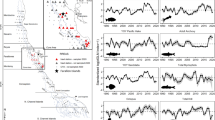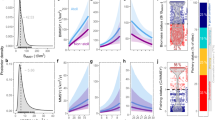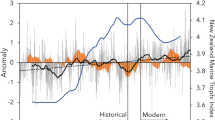Abstract
Biodiversity indicators provide a vital window on the state of the planet, guiding policy development and management1,2. The most widely adopted marine indicator is mean trophic level (MTL) from catches, intended to detect shifts from high-trophic-level predators to low-trophic-level invertebrates and plankton-feeders3,4,5. This indicator underpins reported trends in human impacts, declining when predators collapse (“fishing down marine food webs”)3 and when low-trophic-level fisheries expand (“fishing through marine food webs”)6. The assumption is that catch MTL measures changes in ecosystem MTL and biodiversity2,5. Here we combine model predictions with global assessments of MTL from catches, trawl surveys and fisheries stock assessments7 and find that catch MTL does not reliably predict changes in marine ecosystems. Instead, catch MTL trends often diverge from ecosystem MTL trends obtained from surveys and assessments. In contrast to previous findings of rapid declines in catch MTL3, we observe recent increases in catch, survey and assessment MTL. However, catches from most trophic levels are rising, which can intensify fishery collapses even when MTL trends are stable or increasing. To detect fishing impacts on marine biodiversity, we recommend greater efforts to measure true abundance trends for marine species, especially those most vulnerable to fishing.
This is a preview of subscription content, access via your institution
Access options
Subscribe to this journal
Receive 51 print issues and online access
$199.00 per year
only $3.90 per issue
Buy this article
- Purchase on Springer Link
- Instant access to full article PDF
Prices may be subject to local taxes which are calculated during checkout




Similar content being viewed by others
References
Secretariat of the Convention on Biological Diversity. Global Biodiversity Outlook 2 (Secretariat of the Convention on Biological Diversity, 2006)
Butchart, S. H. M. et al. Global biodiversity: indicators of recent declines. Science 328, 1164–1168 (2010)
Pauly, D., Christensen, V., Dalsgaard, J., Froese, R. & Torres, F. J. Fishing down marine food webs. Science 279, 860–863 (1998)
Pauly, D. & Palomares, M.-L. Fishing down marine food web: it is far more pervasive than we thought. Bull. Mar. Sci. 76, 197–211 (2005)
Pauly, D. & Watson, R. Background and interpretation of the ‘Marine Trophic Index’ as a measure of biodiversity. Phil. Trans. R. Soc. B 360, 415–423 (2005)
Essington, T. E., Beaudreau, A. H. & Wiedenmann, J. Fishing through marine food webs. Proc. Natl Acad. Sci. USA 103, 3171–3175 (2006)
Worm, B. et al. Rebuilding global fisheries. Science 325, 578–585 (2009)
Pikitch, E. K. et al. Ecosystem-based fishery management. Science 305, 346–347 (2004)
Rochet, M.-J. & Trenkel, V. M. Which community indicators can measure the impact of fishing? A review and proposals. Can. J. Fish. Aquat. Sci. 60, 86–99 (2003)
Fulton, E. A., Smith, A. D. M. & Punt, A. E. Which ecological indicators can robustly detect effects of fishing? ICES J. Mar. Sci. 62, 540–551 (2005)
Shin, Y.-J. et al. Using indicators for evaluating, comparing, and communicating the ecological status of exploited marine ecosystems. 2. Setting the scene. ICES J. Mar. Sci. 67, 692–716 (2010)
Shannon, L. J., Coll, M. & Neira, S. Exploring the dynamics of ecological indicators using food web models fitted to time series of abundance and catch data. Ecol. Indic. 9, 1078–1095 (2009)
Yang, J. A tentative analysis of the trophic levels of North Sea fish. Mar. Ecol. Prog. Ser. 7, 247–252 (1982)
Pauly, D., Watson, R. & Alder, J. Global trends in world fisheries: impacts on marine ecosystems and food security. Phil. Trans. R. Soc. B 360, 5–12 (2005)
de Mutsert, K., Cowan, J. H., Jr, Essington, T. E. & Hilborn, R. Reanalyses of Gulf of Mexico fisheries data: landings can be misleading in assessments of fisheries and fisheries ecosystems. Proc. Natl Acad. Sci. USA 105, 2740–2744 (2008)
Caddy, J. F. & Garibaldi, L. Apparent changes in the trophic composition of world marine harvests: the perspective from the FAO capture database. Ocean Coast. Manag. 43, 615–655 (2000)
Caddy, J. F., Csirke, J., Garcia, S. M. & Grainger, R. J. R. How pervasive is “Fishing down marine food webs”? Science 282, 1383a (1998)
Powers, J. E. & Monk, M. H. Current and future use of indicators for ecosystem based fisheries management. Mar. Policy 34, 723–727 (2010)
Sethi, S. A., Branch, T. A. & Watson, R. Fishery development patterns are driven by profit but not trophic level. Proc. Natl Acad. Sci. USA 107, 12163–12167 (2010)
Litzow, M. A. & Urban, D. Fishing through (and up) Alaskan food webs. Can. J. Fish. Aquat. Sci. 66, 201–211 (2009)
Christensen, V. & Walters, C. J. Ecopath with Ecosim: methods, capabilities and limitations. Ecol. Modell. 172, 109–139 (2004)
Tacon, A. G. J., Metian, M., Turchini, G. M. & de Silva, S. S. Responsible aquaculture and trophic level implications to global fish supply. Rev. Fish. Sci. 18, 94–105 (2010)
Tacon, A. G. J. & Metian, M. Fishing for aquaculture: non-food use of small pelagic forage fish—a global perspective. Rev. Fish. Sci. 17, 305–317 (2009)
Froese, R. & Pauly, D. (eds) FishBase <http://www.fishbase.org> Version 03/2010 (2010)
Chavez, F. P., Ryan, J., Lluch-Cota, S. E. & Ñiquen, C. M. From anchovies to sardines and back: multidecadal change in the Pacific Ocean. Science 299, 217–221 (2003)
Zeller, D. & Pauly, D. Good news, bad news: global fisheries discards are declining, but so are total catches. Fish Fish. 6, 156–159 (2005)
Watson, R. & Pauly, D. Systematic distortions in world fisheries catch trends. Nature 414, 534–536 (2001)
Anderson, P. J. & Piatt, J. F. Community reorganization in the Gulf of Alaska following ocean climate regime shift. Mar. Ecol. Prog. Ser. 189, 117–123 (1999)
Mantua, N. J., Hare, S. R., Zhang, Y., Wallace, J. M. & Francis, R. C. A Pacific interdecadal climate oscillation with impacts on salmon production. Bull. Am. Meteorol. Soc. 78, 1069–1079 (1997)
Christensen, V. Fishery-induced changes in a marine ecosystem: insight from models of the Gulf of Thailand. J. Fish Biol. 53 (Suppl. A). 128–142 (1998)
Acknowledgements
This work arose out of a working group at the National Center for Ecological Analysis and Synthesis (NCEAS), funded by the University of California Santa Barbara, the US National Science Foundation (NSF), and the Moore Foundation. T.A.B. was additionally funded by the School of Aquatic and Fishery Sciences, University of Washington. The RAM Legacy stock assessment database was funded by the Canadian Natural Sciences and Engineering Research Council and the Canadian Foundation for Innovation; the Sea Around Us Project was funded by Pew Charitable Trusts. Additional collaborators and data contributors are acknowledged in the Supplementary Information.
Author information
Authors and Affiliations
Contributions
T.A.B. designed the study, analysed the data, and wrote the paper; R.W. analysed the Sea Around Us Project catch data; E.A.F. designed and ran the ecosystem model analyses; S.J. analysed some trawl survey series; C.R.M. combined trawl survey data into a global time series; G.T.P. provided and calculated trophic level estimates; D.R. collated and analysed stock assessment data; and S.R.T. analysed the FAO and Sea Around Us Project catch data. All authors discussed the results and contributed to the manuscript.
Corresponding author
Ethics declarations
Competing interests
The authors declare no competing financial interests.
Supplementary information
Supplementary Information
This file contains Supplementary Methods, Supplementary acknowledgments and additional references, Supplementary Tables 1-6, and Supplementary Figures 1-18 with legends. (PDF 2086 kb)
Rights and permissions
About this article
Cite this article
Branch, T., Watson, R., Fulton, E. et al. The trophic fingerprint of marine fisheries. Nature 468, 431–435 (2010). https://doi.org/10.1038/nature09528
Received:
Accepted:
Published:
Issue Date:
DOI: https://doi.org/10.1038/nature09528
This article is cited by
-
FISHGLOB_data: an integrated dataset of fish biodiversity sampled with scientific bottom-trawl surveys
Scientific Data (2024)
-
Effect of trade on global aquatic food consumption patterns
Nature Communications (2024)
-
Warming indirectly simplifies food webs through effects on apex predators
Nature Ecology & Evolution (2023)
-
A composite fishing index to support the monitoring and sustainable management of world fisheries
Scientific Reports (2023)
-
Assessing fisheries nutrient yields: The Northwest Atlantic, 1950–2014
Ambio (2023)
Comments
By submitting a comment you agree to abide by our Terms and Community Guidelines. If you find something abusive or that does not comply with our terms or guidelines please flag it as inappropriate.



